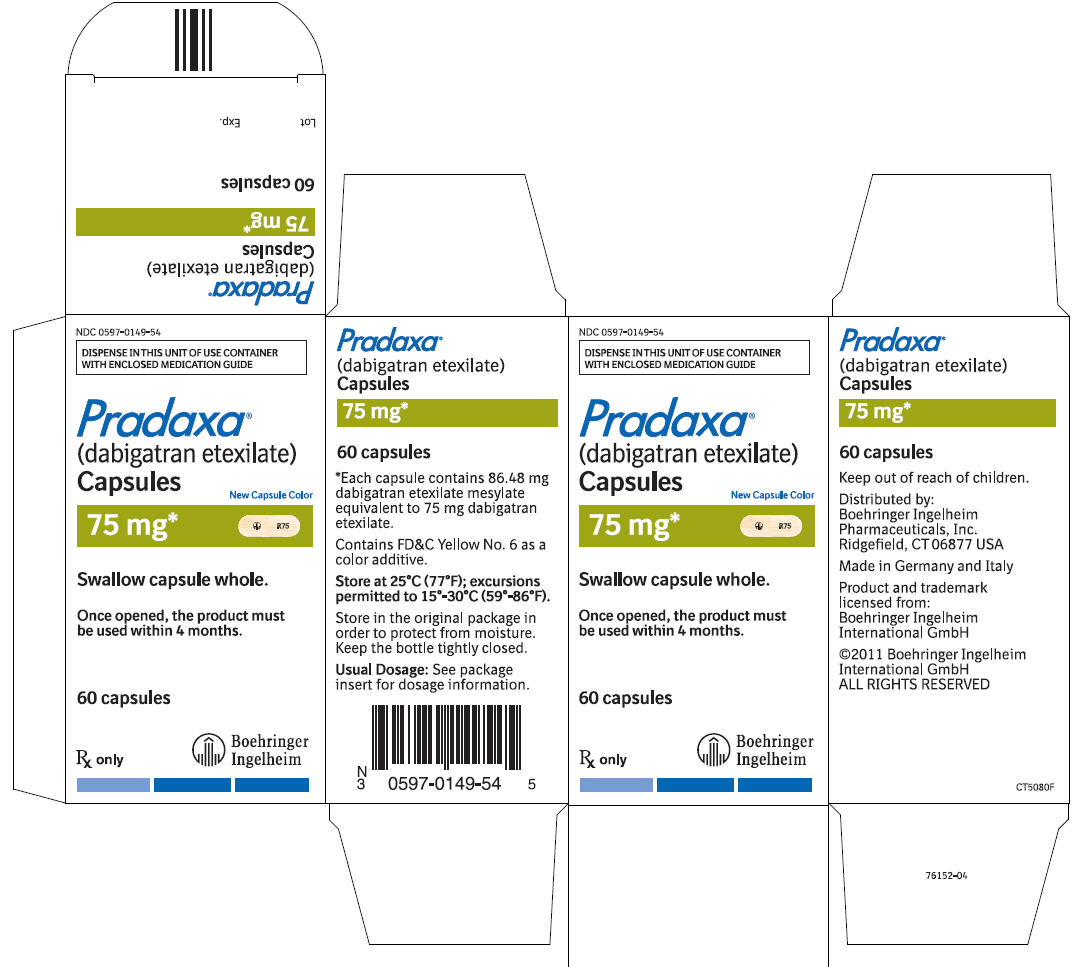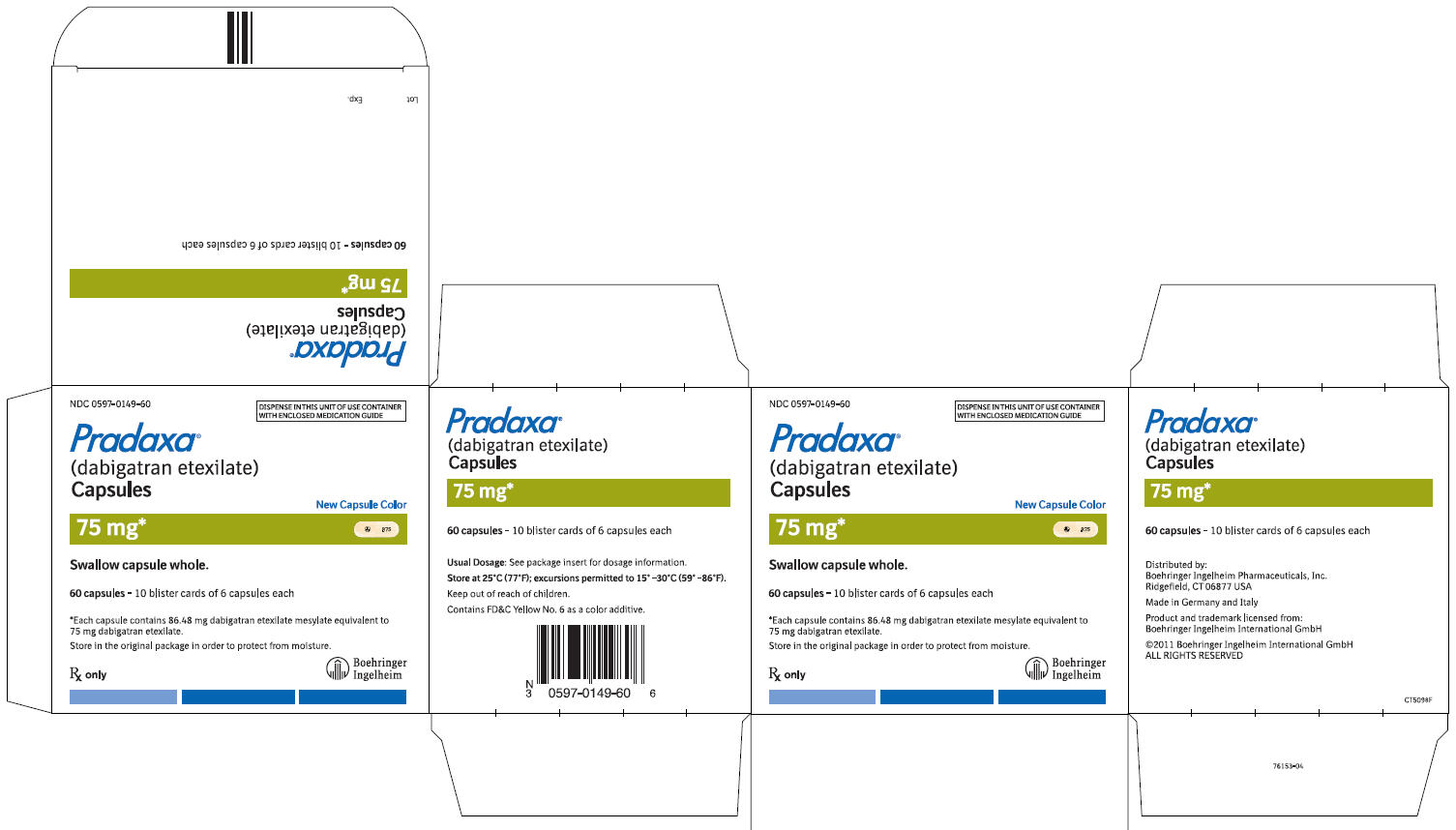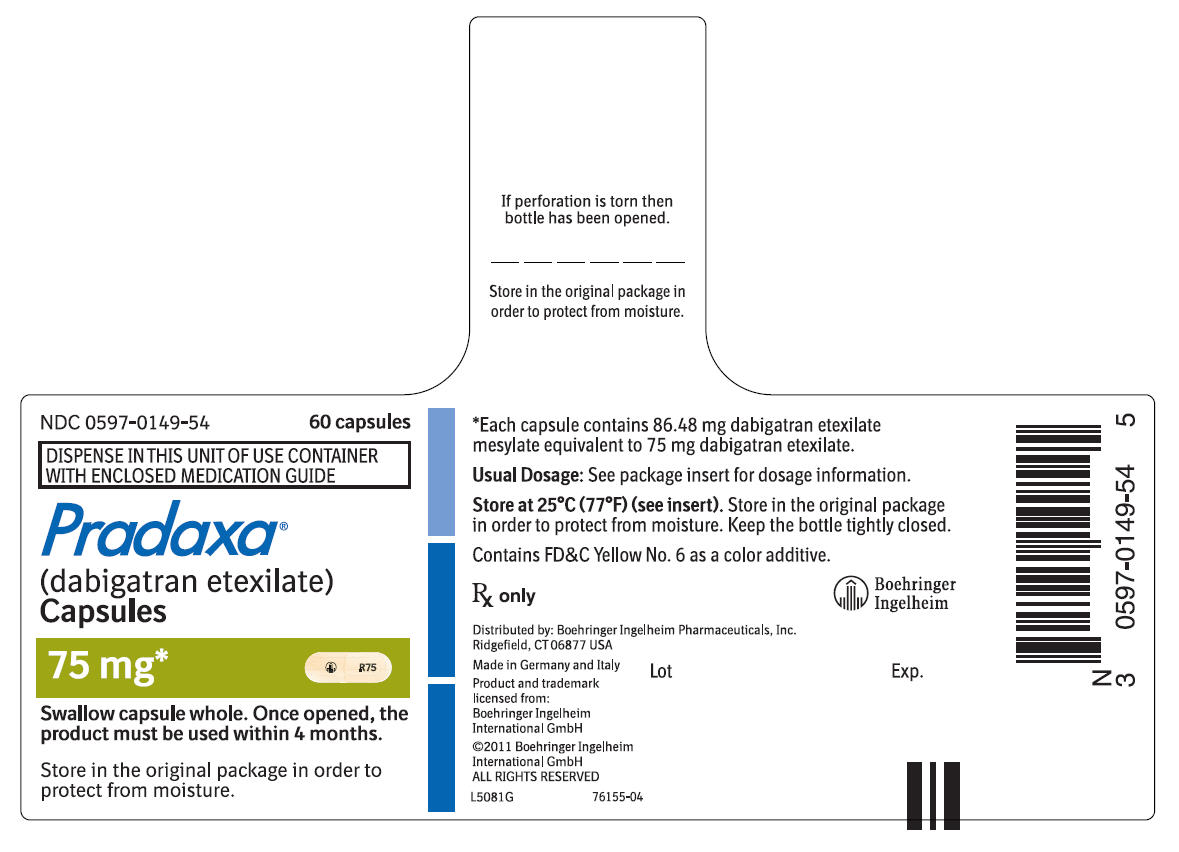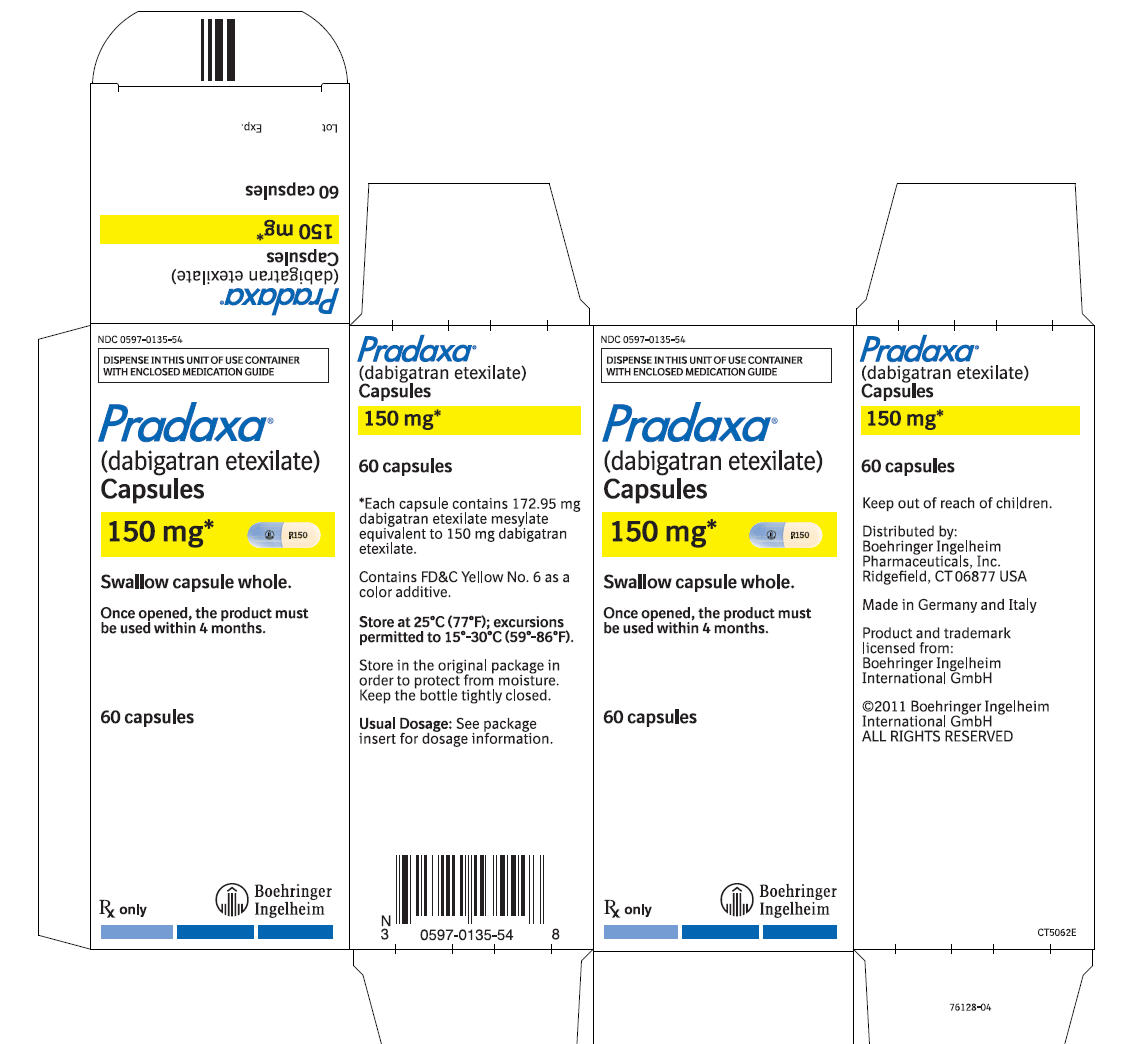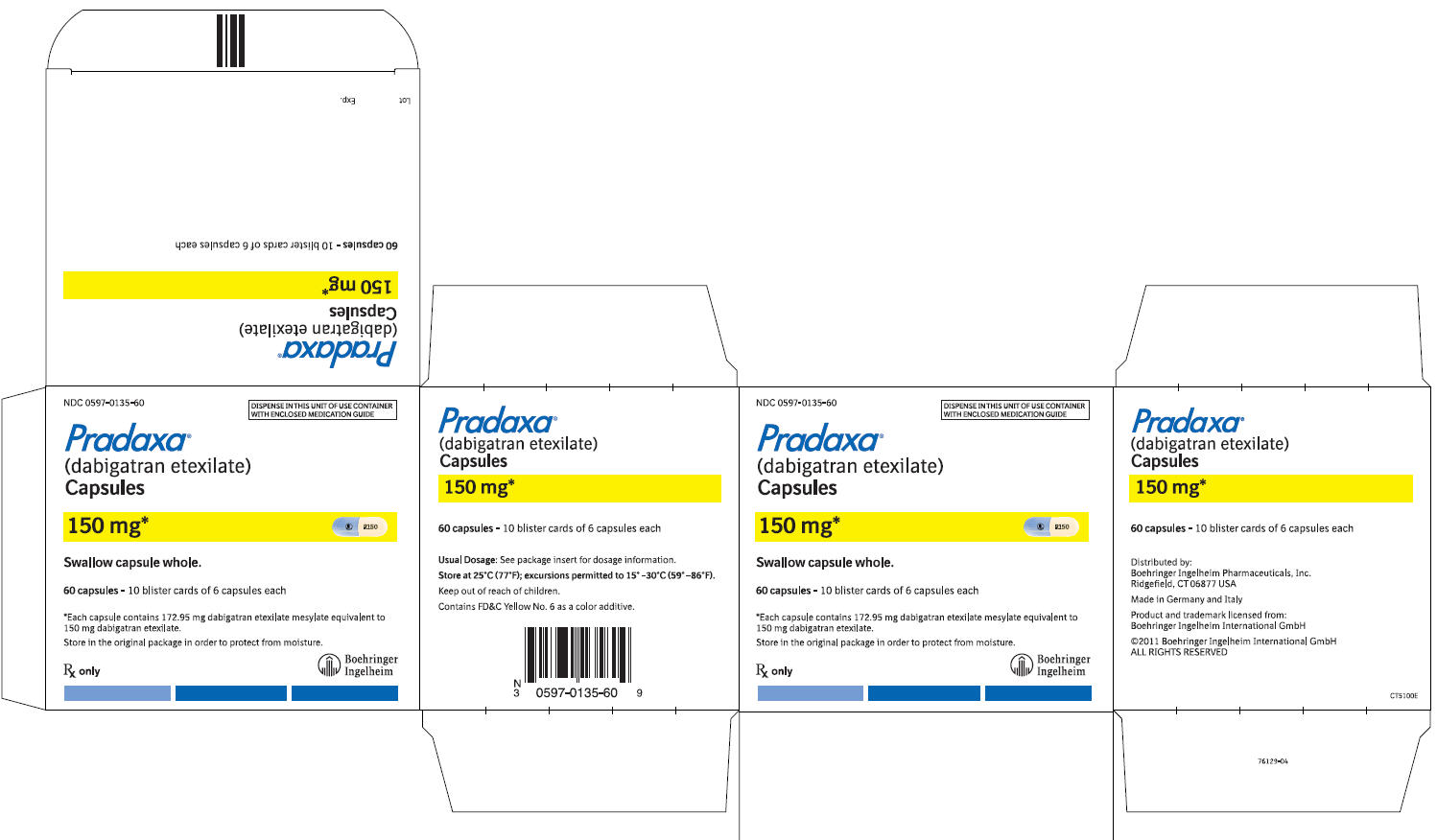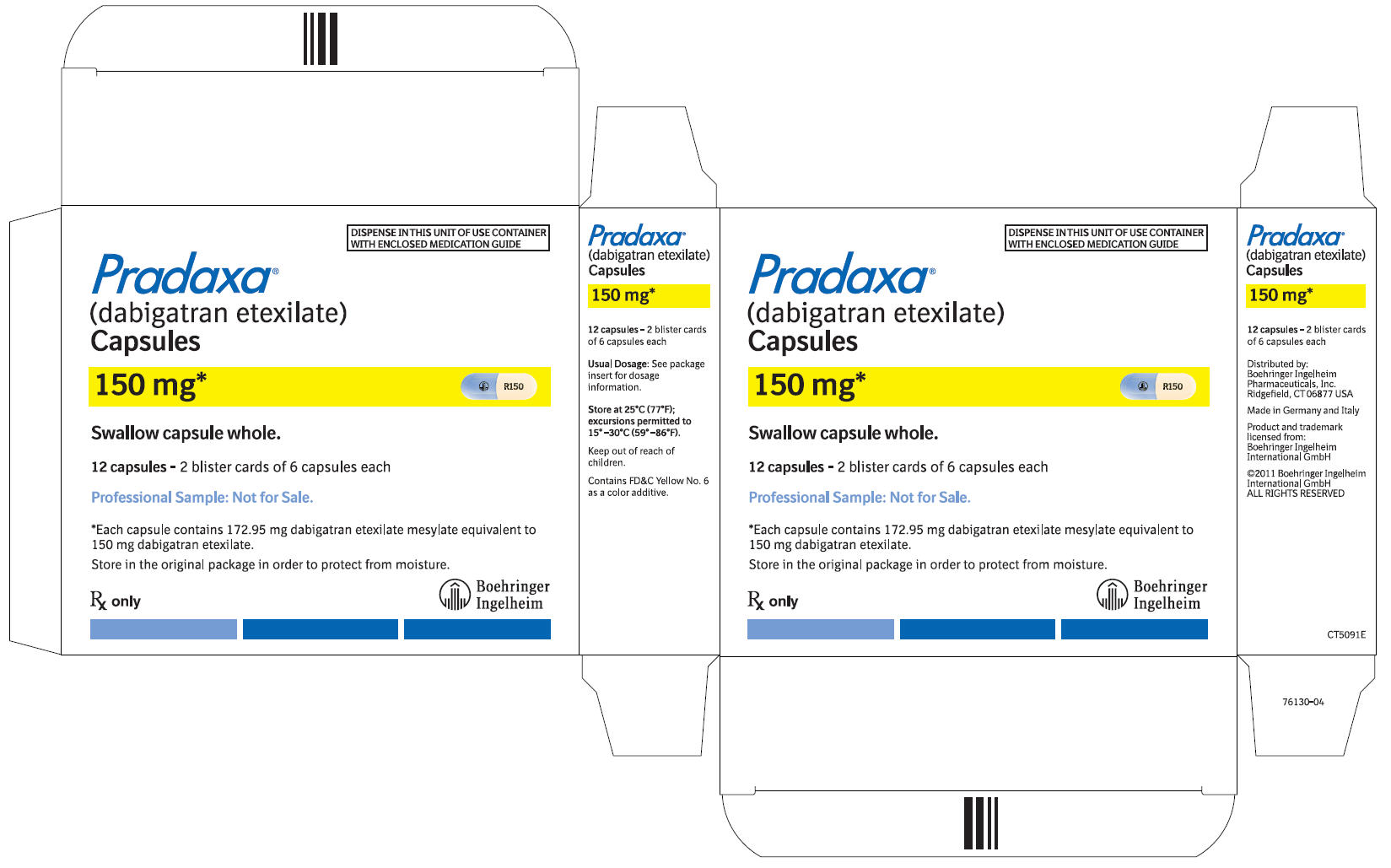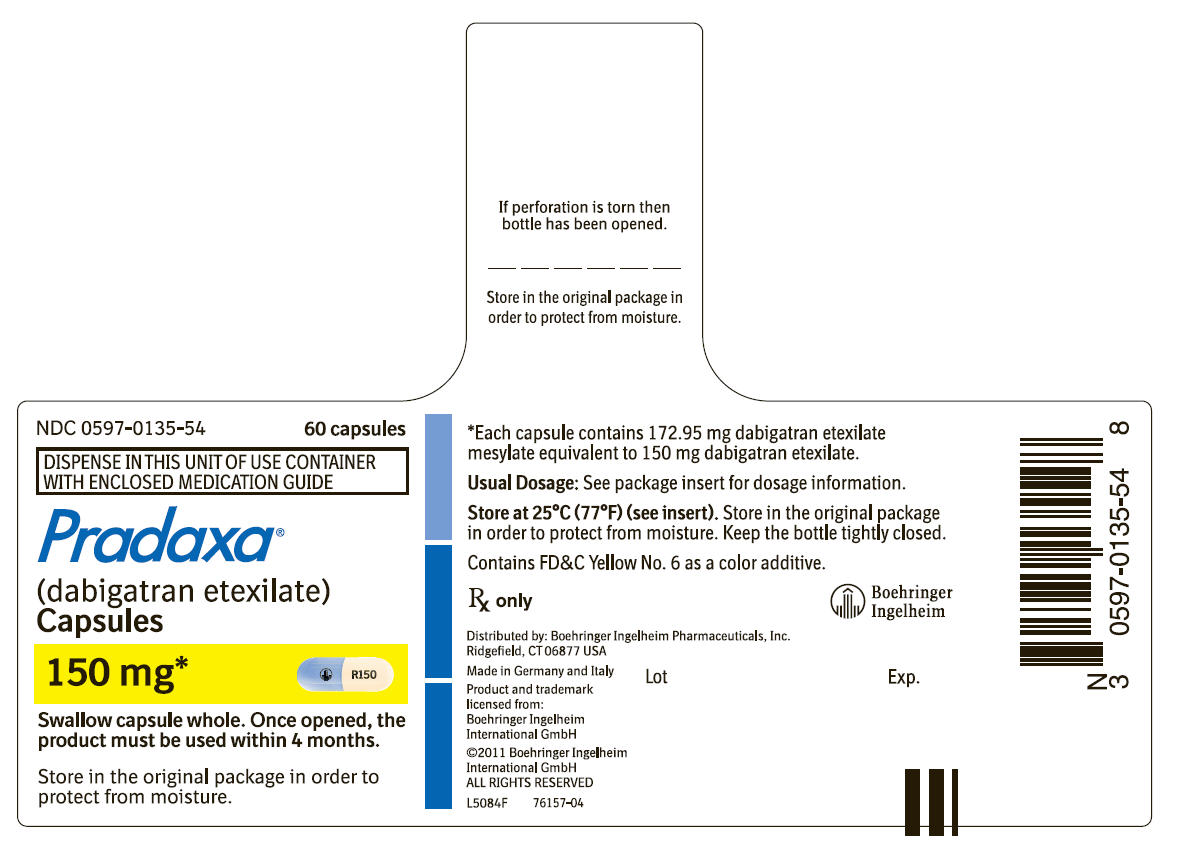PRADAXA
-
dabigatran etexilate mesylate capsule
Boehringer Ingelheim Pharmaceuticals Inc.
----------
|
|||||||||||||||||||||||||||
FULL PRESCRIBING INFORMATION
1 INDICATIONS AND USAGE
PRADAXA is indicated to reduce the risk of stroke and systemic embolism in patients with non-valvular atrial fibrillation.
2 DOSAGE AND ADMINISTRATION
2.1 Recommended Dose
For patients with creatinine clearance (CrCl) >30 mL/min, the recommended dose of PRADAXA is 150 mg taken orally, twice daily, with or without food. For patients with severe renal impairment (CrCl 15-30 mL/min), the recommended dose of PRADAXA is 75 mg twice daily [see Use in Specific Populations (8.6) and Clinical Pharmacology (12.3)]. Dosing recommendations for patients with a CrCl <15 mL/min or on dialysis cannot be provided.
2.2 Dosing Adjustments
Assess renal function prior to initiation of treatment with PRADAXA. Periodically assess renal function as clinically indicated (i.e., more frequently in clinical situations that may be associated with a decline in renal function) and adjust therapy accordingly. Discontinue PRADAXA in patients who develop acute renal failure while on PRADAXA and consider alternative anticoagulant therapy.
In patients with moderate renal impairment (CrCl 30-50 mL/min), concomitant use of the P-gp inhibitor dronedarone or systemic ketoconazole can be expected to produce dabigatran exposure similar to that observed in severe renal impairment. Consider reducing the dose of PRADAXA to 75 mg twice daily [see Drug Interactions (7) and Clinical Pharmacology (12.3)].
Generally, the extent of anticoagulation does not need to be assessed. When necessary, use aPTT or ECT, and not INR, to assess for anticoagulant activity in patients on PRADAXA [see Warnings and Precautions (5.1) and Clinical Pharmacology (12.2)].
2.3 Instructions to Patients
Instruct patients to swallow the capsules whole. Breaking, chewing, or emptying the contents of the capsule can result in increased exposure [see Clinical Pharmacology (12.3)].
If a dose of PRADAXA is not taken at the scheduled time, the dose should be taken as soon as possible on the same day; the missed dose should be skipped if it cannot be taken at least 6 hours before the next scheduled dose. The dose of PRADAXA should not be doubled to make up for a missed dose.
2.4 Converting from or to Warfarin
When converting patients from warfarin therapy to PRADAXA, discontinue warfarin and start PRADAXA when the INR is below 2.0.
When converting from PRADAXA to warfarin, adjust the starting time of warfarin based on creatinine clearance as follows:
- For CrCl ≥50 mL/min, start warfarin 3 days before discontinuing PRADAXA.
- For CrCl 30-50 mL/min, start warfarin 2 days before discontinuing PRADAXA.
- For CrCl 15-30 mL/min, start warfarin 1 day before discontinuing PRADAXA.
- For CrCl <15 mL/min, no recommendations can be made.
Because PRADAXA can increase INR, the INR will better reflect warfarin’s effect only after PRADAXA has been stopped for at least 2 days [see Clinical Pharmacology (12.2)].
2.5 Converting from or to Parenteral Anticoagulants
For patients currently receiving a parenteral anticoagulant, start PRADAXA 0 to 2 hours before the time that the next dose of the parenteral drug was to have been administered or at the time of discontinuation of a continuously administered parenteral drug (e.g., intravenous unfractionated heparin).
For patients currently taking PRADAXA, wait 12 hours (CrCl ≥30 mL/min) or 24 hours (CrCl <30 mL/min) after the last dose of PRADAXA before initiating treatment with a parenteral anticoagulant [see Clinical Pharmacology (12.3)].
2.6 Surgery and Interventions
If possible, discontinue PRADAXA 1 to 2 days (CrCl ≥50 mL/min) or 3 to 5 days (CrCl <50 mL/min) before invasive or surgical procedures because of the increased risk of bleeding. Consider longer times for patients undergoing major surgery, spinal puncture, or placement of a spinal or epidural catheter or port, in whom complete hemostasis may be required [see Use in Specific Populations (8.6) and Clinical Pharmacology (12.3)].
If surgery cannot be delayed, there is an increased risk of bleeding [see Warnings and Precautions (5.1)]. This risk of bleeding should be weighed against the urgency of intervention [see Warnings and Precautions (5.2)].
3 DOSAGE FORMS AND STRENGTHS
150 mg capsules with a light blue opaque cap imprinted in black with the Boehringer Ingelheim company symbol and a cream-colored opaque body imprinted in black with "R150".
75 mg capsules with a cream-colored opaque cap imprinted in black with the Boehringer Ingelheim company symbol and a cream-colored opaque body imprinted in black with "R75".
5 WARNINGS AND PRECAUTIONS
5.1 Risk of Bleeding
PRADAXA increases the risk of bleeding and can cause significant and, sometimes, fatal bleeding. Promptly evaluate any signs or symptoms of blood loss (e.g., a drop in hemoglobin and/or hematocrit or hypotension). Discontinue PRADAXA in patients with active pathological bleeding [see Dosage and Administration (2.2)].
Risk factors for bleeding include the use of other drugs that increase the risk of bleeding (e.g., anti-platelet agents, heparin, fibrinolytic therapy, and chronic use of NSAIDs). PRADAXA’s anticoagulant activity and half-life are increased in patients with renal impairment [see Clinical Pharmacology (12.2)].
A specific reversal agent for dabigatran is not available. Dabigatran can be dialyzed (protein binding is low, with the removal of about 60% of drug over 2-3 hours); however the amount of data supporting this approach is limited. Activated prothrombin complex concentrates (aPCCs, e.g., FEIBA), or recombinant Factor VIIa, or concentrates of coagulation factors II, IX or X may be considered but their use has not been evaluated in clinical trials. Protamine sulfate and vitamin K are not expected to affect the anticoagulant activity of dabigatran. Consider administration of platelet concentrates in cases where thrombocytopenia is present or long-acting antiplatelet drugs have been used.
5.2 Temporary Discontinuation of PRADAXA
Discontinuing anticoagulants, including PRADAXA, for active bleeding, elective surgery, or invasive procedures, places patients at an increased risk of stroke. Minimize lapses in therapy.
5.3 Effect of P-gp Inducers and Inhibitors on Dabigatran Exposure
The concomitant use of PRADAXA with P-gp inducers (e.g. rifampin) reduces exposure to dabigatran and should generally be avoided [see Clinical Pharmacology (12.3)].
P-gp inhibition and impaired renal function are the major independent factors that result in increased exposure to dabigatran [see Clinical Pharmacology (12.3)]. Concomitant use of P-gp inhibitors in patients with renal impairment is expected to produce increased exposure of dabigatran compared to that seen with either factor alone.
Consider reducing the dose of PRADAXA to 75 mg twice daily when dronedarone or systemic ketoconazole is coadministered with PRADAXA in patients with moderate renal impairment (CrCl 30-50 mL/min). Avoid use of PRADAXA and P-gp inhibitors in patients with severe renal impairment (CrCl 15-30 mL/min) [see Drug Interactions (7) and Use in Specific Populations (8.6)].
6 ADVERSE REACTIONS
6.1 Clinical Trials Experience
Because clinical trials are conducted under widely varying conditions, adverse reactions rates observed in the clinical trials of a drug cannot be directly compared to rates in the clinical trials of another drug and may not reflect the rates observed in practice.
The RE-LY (Randomized Evaluation of Long-term Anticoagulant Therapy) study provided safety information on the use of two doses of PRADAXA and warfarin [see Clinical Studies (14)]. The numbers of patients and their exposures are described in Table 1. Limited information is presented on the 110 mg dosing arm because this dose is not approved.
| PRADAXA 110 mg twice daily | PRADAXA 150 mg twice daily | Warfarin | |
| Total number treated | 5983 | 6059 | 5998 |
| Exposure | |||
| > 12 months | 4936 | 4939 | 5193 |
| > 24 months | 2387 | 2405 | 2470 |
| Mean exposure (months) | 20.5 | 20.3 | 21.3 |
| Total patient-years | 10,242 | 10,261 | 10,659 |
Drug Discontinuation in RE-LY
The rates of adverse reactions leading to treatment discontinuation were 21% for PRADAXA 150 mg and 16% for warfarin. The most frequent adverse reactions leading to discontinuation of PRADAXA were bleeding and gastrointestinal events (i.e., dyspepsia, nausea, upper abdominal pain, gastrointestinal hemorrhage, and diarrhea).
Bleeding [see Warnings and Precautions (5.1)]
Table 2 shows the number of patients experiencing serious bleeding during the treatment period in the RE-LY study, with the bleeding rate per 100 patient-years (%). Major bleeds fulfilled one or more of the following criteria: bleeding associated with a reduction in hemoglobin of at least 2 grams per deciliter or leading to a transfusion of at least 2 units of blood, or symptomatic bleeding in a critical area or organ (intraocular, intracranial, intraspinal or intramuscular with compartment syndrome, retroperitoneal bleeding, intra-articular bleeding, or pericardial bleeding). A life-threatening bleed met one or more of the following criteria: fatal, symptomatic intracranial bleed, reduction in hemoglobin of at least 5 grams per deciliter, transfusion of at least 4 units of blood, associated with hypotension requiring the use of intravenous inotropic agents, or necessitating surgical intervention. Intracranial hemorrhage included intracerebral (hemorrhagic stroke), subarachnoid, and subdural bleeds.
| PRADAXA 150 mg twice daily N (%) | Warfarin N (%) | Hazard Ratio (95% CI**) |
|
| * Patients contributed multiple events and events were counted in multiple categories. ** Confidence interval |
|||
| Randomized patients | 6076 | 6022 | |
| Patient-years | 12,033 | 11,794 | |
| Intracranial hemorrhage | 38 (0.3) | 90 (0.8) | 0.41 (0.28, 0.60) |
| Life-threatening bleed | 179 (1.5) | 218 (1.9) | 0.80 (0.66, 0.98) |
| Major bleed | 399 (3.3) | 421 (3.6) | 0.93 (0.81, 1.07) |
| Any bleed | 1993 (16.6) | 2166 (18.4) | 0.91 (0.85, 0.96) |
The risk of major bleeds was similar with PRADAXA 150 mg and warfarin across major subgroups defined by baseline characteristics, with the exception of age, where there was a trend towards a higher incidence of major bleeding on PRADAXA (hazard ratio 1.2, 95% CI: 1.0 to 1.4) for patients ≥75 years of age.
There was a higher rate of major gastrointestinal bleeds in patients receiving PRADAXA 150 mg than in patients receiving warfarin (1.6% vs. 1.1%, respectively, with a hazard ratio vs. warfarin of 1.5, 95% CI, 1.2 to 1.9), and a higher rate of any gastrointestinal bleeds (6.1% vs. 4.0%, respectively).
Gastrointestinal Adverse Reactions
Patients on PRADAXA 150 mg had an increased incidence of gastrointestinal adverse reactions (35% vs. 24% on warfarin). These were commonly dyspepsia (including abdominal pain upper, abdominal pain, abdominal discomfort, and epigastric discomfort) and gastritis-like symptoms (including GERD, esophagitis, erosive gastritis, gastric hemorrhage, hemorrhagic gastritis, hemorrhagic erosive gastritis, and gastrointestinal ulcer).
7 DRUG INTERACTIONS
The concomitant use of PRADAXA with P-gp inducers (e.g., rifampin) reduces exposure to dabigatran and should generally be avoided [see Clinical Pharmacology (12.3)].
P-gp inhibition and impaired renal function are the major independent factors that result in increased exposure to dabigatran [see Clinical Pharmacology (12.3)]. Concomitant use of P-gp inhibitors in patients with renal impairment is expected to produce increased exposure of dabigatran compared to that seen with either factor alone.
In patients with moderate renal impairment (CrCl 30-50 mL/min), consider reducing the dose of PRADAXA to 75 mg twice daily when administered concomitantly with the P-gp inhibitor dronedarone or systemic ketoconazole. The use of P-gp inhibitors (verapamil, amiodarone, quinidine, and clarithromycin) does not require a dose adjustment of PRADAXA. These results should not be extrapolated to other P-gp inhibitors [see Warnings and Precautions (5.3), Use in Specific Populations (8.6), and Clinical Pharmacology (12.3)].
The concomitant use of PRADAXA and P-gp inhibitors in patients with severe renal impairment (CrCl 15-30 mL/min) should be avoided [see Warnings and Precautions (5.3), Use in Specific Populations (8.6), and Clinical Pharmacology (12.3)].
8 USE IN SPECIFIC POPULATIONS
8.1 Pregnancy
Pregnancy Category C
There are no adequate and well-controlled studies in pregnant women.
Dabigatran has been shown to decrease the number of implantations when male and female rats were treated at a dosage of 70 mg/kg (about 2.6 to 3.0 times the human exposure at maximum recommended human dose [MRHD] of 300 mg/day based on area under the curve [AUC] comparisons) prior to mating and up to implantation (gestation Day 6). Treatment of pregnant rats after implantation with dabigatran at the same dose increased the number of dead offspring and caused excess vaginal/uterine bleeding close to parturition. Although dabigatran increased the incidence of delayed or irregular ossification of fetal skull bones and vertebrae in the rat, it did not induce major malformations in rats or rabbits.
8.2 Labor and Delivery
Safety and effectiveness of PRADAXA during labor and delivery have not been studied in clinical trials. Consider the risks of bleeding and of stroke in using PRADAXA in this setting [see Warnings and Precautions (5.1)].
Death of offspring and mother rats during labor in association with uterine bleeding occurred during treatment of pregnant rats from implantation (gestation Day 7) to weaning (lactation Day 21) with dabigatran at a dose of 70 mg/kg (about 2.6 times the human exposure at MRHD of 300 mg/day based on AUC comparisons).
8.3 Nursing Mothers
It is not known whether dabigatran is excreted in human milk. Because many drugs are excreted in human milk, caution should be exercised when PRADAXA is administered to a nursing woman.
8.4 Pediatric Use
Safety and effectiveness of PRADAXA in pediatric patients have not been established.
8.5 Geriatric Use
Of the total number of patients in the RE-LY study, 82% were 65 and over, while 40% were 75 and over. The risk of stroke and bleeding increases with age, but the risk-benefit profile is favorable in all age groups [see Warnings and Precautions (5), Adverse Reactions (6.1), and Clinical Studies (14)].
8.6 Renal Impairment
No dose adjustment of PRADAXA is recommended in patients with mild or moderate renal impairment [see Clinical Pharmacology (12.3)]. Reduce the dose of PRADAXA in patients with severe renal impairment (CrCl 15-30 mL/min) [see Dosage and Administration (2.1, 2.2) and Clinical Pharmacology (12.3)]. Dosing recommendations for patients with CrCl <15 mL/min or on dialysis cannot be provided.
Adjust dose appropriately in patients with renal impairment receiving concomitant P-gp inhibitors [see Warnings and Precautions (5.3), Drug Interactions (7), and Clinical Pharmacology (12.3)].
10 OVERDOSAGE
Accidental overdose may lead to hemorrhagic complications. There is no reversal agent for dabigatran. In the event of hemorrhagic complications, initiate appropriate clinical support, discontinue treatment with PRADAXA, and investigate the source of bleeding. Dabigatran is primarily excreted in the urine and shows low plasma protein binding. Therefore, dabigatran can be dialyzed with the removal of about 60% of drug over 2 to 3 hours; however, data supporting this approach are limited. Measurement of aPTT or ECT may help guide therapy [see Warnings and Precautions (5.1) Clinical Pharmacology (12.2)]
11 DESCRIPTION
The chemical name for dabigatran etexilate mesylate, a direct thrombin inhibitor, is β-Alanine, N-[[2-[[[4-[[[(hexyloxy)carbonyl]amino]iminomethyl] phenyl]amino]methyl]-1-methyl-1H-benzimidazol-5-yl]carbonyl]-N-2-pyridinyl-,ethyl ester, methanesulfonate. The empirical formula is C34H41N7O5 • CH4O3S and the molecular weight is 723.86 (mesylate salt), 627.75 (free base). The structural formula is:
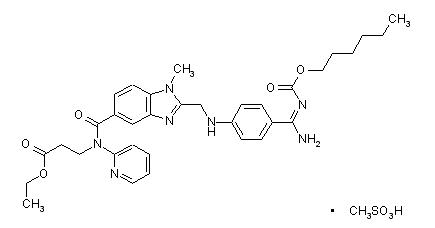
Dabigatran etexilate mesylate is a yellow-white to yellow powder. A saturated solution in pure water has a solubility of 1.8 mg/mL. It is freely soluble in methanol, slightly soluble in ethanol, and sparingly soluble in isopropanol.
The 150 mg capsule for oral administration contains 172.95 mg dabigatran etexilate mesylate, which is equivalent to 150 mg of dabigatran etexilate, and the following inactive ingredients: acacia, dimethicone, hypromellose, hydroxypropyl cellulose, talc, and tartaric acid. The capsule shell is composed of carrageenan, FD&C Blue No. 2 (150 mg only), FD&C Yellow No. 6, hypromellose, potassium chloride, titanium dioxide, and black edible ink. The 75 mg capsule contains 86.48 mg dabigatran etexilate mesylate, equivalent to 75 mg dabigatran etexilate, and is otherwise similar to the 150 mg capsule.
12 CLINICAL PHARMACOLOGY
12.1 Mechanism of Action
Dabigatran and its acyl glucuronides are competitive, direct thrombin inhibitors. Because thrombin (serine protease) enables the conversion of fibrinogen into fibrin during the coagulation cascade, its inhibition prevents the development of a thrombus. Both free and clot-bound thrombin, and thrombin-induced platelet aggregation are inhibited by the active moieties.
12.2 Pharmacodynamics
At recommended therapeutic doses, dabigatran etexilate prolongs the coagulation markers such as aPTT, ECT, and TT. INR is relatively insensitive to the exposure to dabigatran and cannot be interpreted the same way as used for warfarin monitoring.
The aPTT test provides an approximation of PRADAXA’s anticoagulant effect. The average time course for effects on aPTT, following approved dosing regimens in patients with various degrees of renal impairment is shown in Figure 1. The curves represent mean levels without confidence intervals; variations should be expected when measuring aPTT. While advice cannot be provided on the level of recovery of aPTT needed in any particular clinical setting, the curves can be used to estimate the time to get to a particular level of recovery, even when the time since the last dose of PRADAXA is not precisely known. In the RE-LY trial, the median (10th to 90th percentile) trough aPTT in patients receiving the 150 mg dose was 52 (40 to 76) seconds.
Figure 1 Average Time Course for Effects of Dabigatran on aPTT, Following Approved PRADAXA Dosing Regimens in Patients with Various Degrees of Renal Impairment*
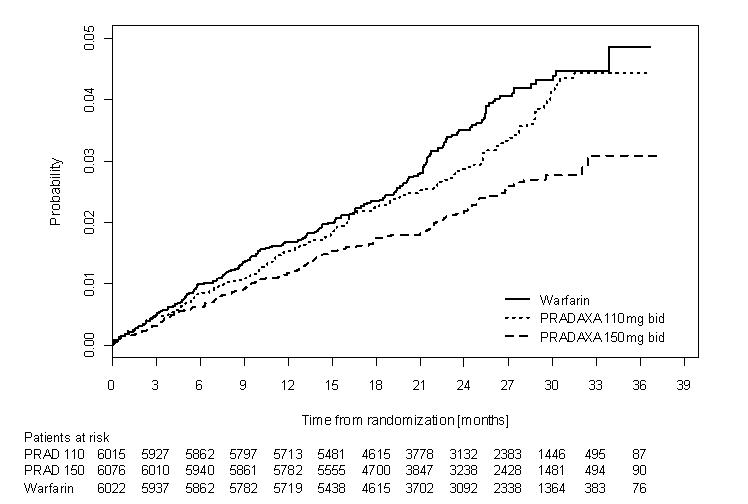
*Simulations based on PK data from a study in subjects with renal impairment and PK/aPTT relationships derived from the RE-LY study; aPTT prolongation in RE-LY was measured centrally in citrate plasma using PTT Reagent Roche Diagnostics GmbH, Mannheim, Germany. There may be quantitative differences between various established methods for aPTT assessment.
The degree of anticoagulant activity can also be assessed by the ecarin clotting time (ECT). This test is a more specific measure of the effect of dabigatran than activated partial thromboplastin time (aPTT). In the RE-LY trial, the median (10th to 90th percentile) trough ECT in patients receiving the 150 mg dose was 63 (44 to 103) seconds.
12.3 Pharmacokinetics
Dabigatran etexilate mesylate is absorbed as the dabigatran etexilate ester. The ester is then hydrolyzed, forming dabigatran, the active moiety. Dabigatran is metabolized to four different acyl glucuronides and both the glucuronides and dabigatran have similar pharmacological activity. Pharmacokinetics described here refer to the sum of dabigatran and its glucuronides. Dabigatran displays dose-proportional pharmacokinetics in healthy subjects and patients in the range of doses from 10 to 400 mg.
Absorption
The absolute bioavailability of dabigatran following oral administration of dabigatran etexilate is approximately 3 to 7%. Dabigatran etexilate is a substrate of the efflux transporter P-gp. After oral administration of dabigatran etexilate in healthy volunteers, Cmax occurs at 1 hour post-administration in the fasted state. Coadministration of PRADAXA with a high-fat meal delays the time to Cmax by approximately 2 hours but has no effect on the bioavailability of dabigatran; PRADAXA may be administered with or without food.
The oral bioavailability of dabigatran etexilate increases by 75% when the pellets are taken without the capsule shell compared to the intact capsule formulation. PRADAXA capsules should therefore not be broken, chewed, or opened before administration.
Distribution
Dabigatran is approximately 35% bound to human plasma proteins. The red blood cell to plasma partitioning of dabigatran measured as total radioactivity is less than 0.3. The volume of distribution of dabigatran is 50 to 70 L. Dabigatran pharmacokinetics are dose proportional after single doses of 10 to 400 mg. Given twice daily, dabigatran’s accumulation factor is approximately two.
Elimination
Dabigatran is eliminated primarily in the urine. Renal clearance of dabigatran is 80% of total clearance after intravenous administration. After oral administration of radiolabeled dabigatran, 7% of radioactivity is recovered in urine and 86% in feces. The half-life of dabigatran in healthy subjects is 12 to 17 hours.
Metabolism
After oral administration, dabigatran etexilate is converted to dabigatran. The cleavage of the dabigatran etexilate by esterase-catalyzed hydrolysis to the active principal dabigatran is the predominant metabolic reaction. Dabigatran is not a substrate, inhibitor, or inducer of CYP450 enzymes. Dabigatran is subject to conjugation forming pharmacologically active acyl glucuronides. Four positional isomers, 1-O, 2-O, 3-O, and 4-O-acylglucuronide exist, and each accounts for less than 10% of total dabigatran in plasma.
Renal Impairment
An open, parallel-group single-center study compared dabigatran pharmacokinetics in healthy subjects and patients with mild to moderate renal impairment receiving a single dose of PRADAXA 150 mg. Exposure to dabigatran increases with severity of renal function impairment (Table 3). Similar findings were observed in the RE-LY trial.
| Renal Function | CrCl (mL/min) | Increase in AUC | Increase in Cmax | t1/2
(h) |
| +Patients with severe renal impairment were not studied in RE-LY. Dosing recommendations in subjects with severe renal impairment are based on pharmacokinetic modeling [see Dosage and Administration (2.1) and Use in Specific Populations (8.6)]. | ||||
| Normal | ≥ 80 | 1x | 1x | 13 |
| Mild | 50-80 | 1.5x | 1.1x | 15 |
| Moderate | 30-50 | 3.2x | 1.7x | 18 |
| Severe+ | 15-30 | 6.3x | 2.1x | 27 |
Hepatic Impairment
Administration of PRADAXA in patients with moderate hepatic impairment (Child-Pugh B) showed a large inter-subject variability, but no evidence of a consistent change in exposure or pharmacodynamics.
P-gp Inducers
Rifampin: Rifampin 600 mg once daily for 7 days followed by a single dose of dabigatran decreased its AUC and Cmax by 66% and 67%, respectively. By Day 7 after cessation of rifampin treatment, dabigatran exposure was close to normal [see Warnings and Precautions (5.3) and Drug Interactions (7)].
P-gp Inhibitors
In studies with the P-gp inhibitors ketoconazole, amiodarone, verapamil, and quinidine, the time to peak, terminal half-life, and mean residence time of dabigatran were not affected. Any observed changes in Cmax and AUC are described below.
Dronedarone: Exposure to dabigatran is 73-99% higher when it is administered with dronedarone than when it is administered alone.
Ketoconazole: Systemic ketoconazole increased dabigatran AUC and Cmax values by 138% and 135%, respectively, after a single dose of 400 mg, and 153%, and 149%, respectively, after multiple daily doses of 400 mg.
Verapamil: When dabigatran etexilate was coadministered with oral verapamil, the Cmax and AUC of dabigatran were increased. The extent of increase depends on the formulation of verapamil and timing of administration. If verapamil is present in the gut when dabigatran is taken, it will increase exposure to dabigatran with the greatest increase observed when a single dose of immediate-release verapamil is given one hour prior to dabigatran (AUC increased by a factor of 2.4). If verapamil is given 2 hours after dabigatran, the increase in AUC is negligible. In the population pharmacokinetics study from RE-LY, no important changes in dabigatran trough levels were observed in patients who received verapamil.
Amiodarone: When dabigatran etexilate was coadministered with a single 600 mg oral dose of amiodarone, the dabigatran AUC and Cmax increased by 58% and 50%, respectively. The increase in exposure was mitigated by a 65% increase in the renal clearance of dabigatran in the presence of amiodarone. The increase in renal clearance may persist after amiodarone is discontinued because of amiodarone’s long half-life. In the population pharmacokinetics study from RE-LY, no important changes in dabigatran trough levels were observed in patients who received amiodarone.
Quinidine: Quinidine was given as 200 mg dose every 2 hours up to a total dose of 1000 mg. Dabigatran etexilate was given over 3 consecutive days, the last evening dose on Day 3 with or without quinidine pre-dosing. Concomitant quinidine administration increased dabigatran’s AUC and Cmax by 53% and 56%, respectively.
Clarithromycin: Coadministered clarithromycin had no impact on the exposure to dabigatran.
Other Drugs
Clopidogrel: When dabigatran etexilate was given concomitantly with a loading dose of 300 mg or 600 mg clopidogrel, the dabigatran AUC and Cmax increased by approximately 30% and 40%, respectively. The concomitant administration of dabigatran etexilate and clopidogrel resulted in no further prolongation of capillary bleeding times compared to clopidogrel monotherapy. When comparing combined treatment and the respective mono-treatments, the coagulation measures for dabigatran’s effect (aPTT, ECT, and TT) remained unchanged, and inhibition of platelet aggregation (IPA), a measurement of clopidogrel’s effect, remained unchanged.
Enoxaparin: Enoxaparin 40 mg given subcutaneously for 3 days with the last dose given 24 hours before a single dose of PRADAXA had no impact on the exposure to dabigatran or the coagulation measures aPTT, ECT, or TT.
Diclofenac, Ranitidine, and Digoxin: None of these drugs alters exposure to dabigatran.
In RE-LY, dabigatran plasma samples were also collected. The concomitant use of proton pump inhibitors, H2 antagonists, and digoxin did not appreciably change the trough concentration of dabigatran.
13 NONCLINICAL TOXICOLOGY
13.1 Carcinogenesis, Mutagenesis, Impairment of Fertility
Dabigatran was not carcinogenic when administered by oral gavage to mice and rats for up to 2 years. The highest doses tested (200 mg/kg/day) in mice and rats were approximately 3.6 and 6 times, respectively, the human exposure at MRHD of 300 mg/day based on AUC comparisons.
Dabigatran was not mutagenic in in vitro tests, including bacterial reversion tests, mouse lymphoma assay and chromosomal aberration assay in human lymphocytes, and the in vivo micronucleus assay in rats.
In the rat fertility study with oral gavage doses of 15, 70, and 200 mg/kg, males were treated for 29 days prior to mating, during mating up to scheduled termination, and females were treated 15 days prior to mating through gestation Day 6. No adverse effects on male or female fertility were observed at 200 mg/kg or 9 to 12 times the human exposure at MRHD of 300 mg/day based on AUC comparisons. However, the number of implantations decreased in females receiving 70 mg/kg, or 3 times the human exposure at MRHD based on AUC comparisons.
14 CLINICAL STUDIES
The clinical evidence for the efficacy of PRADAXA was derived from RE-LY (Randomized Evaluation of Long-term Anticoagulant Therapy), a multi-center, multi-national, randomized parallel group trial comparing two blinded doses of PRADAXA (110 mg twice daily and 150 mg twice daily) with open-label warfarin (dosed to target INR of 2 to 3) in patients with non-valvular, persistent, paroxysmal, or permanent atrial fibrillation and one or more of the following additional risk factors:
- Previous stroke, transient ischemic attack (TIA), or systemic embolism
- Left ventricular ejection fraction <40%
- Symptomatic heart failure, ≥ New York Heart Association Class 2
- Age ≥75 years
- Age ≥65 years and one of the following: diabetes mellitus, coronary artery disease (CAD), or hypertension
The primary objective of this study was to determine if PRADAXA was non-inferior to warfarin in reducing the occurrence of the composite endpoint, stroke (ischemic and hemorrhagic) and systemic embolism. The study was designed to ensure that PRADAXA preserved more than 50% of warfarin’s effect as established by previous randomized, placebo-controlled trials of warfarin in atrial fibrillation. Statistical superiority was also analyzed.
A total of 18,113 patients were randomized and followed for a median of 2 years. The patient’s mean age was 71.5 years and the mean CHADS2 score was 2.1. The patient population was 64% male, 70% Caucasian, 16% Asian, and 1% black. Twenty percent of patients had a history of a stroke or TIA and 50% were Vitamin K antagonist (VKA) naïve, defined as less than 2 months total lifetime exposure to a VKA. Thirty-two percent of the population had never been exposed to a VKA. Concomitant diseases of patients in this trial included hypertension 79%, diabetes 23%, and CAD 28%. At baseline, 40% of patients were on aspirin and 6% were on clopidogrel. For patients randomized to warfarin, the mean percentage of time in therapeutic range (INR 2 to 3) was 64%; the mean percentages of time INR measurements were greater than 4 or less than 1.5 were 2% and 5%, respectively.
Relative to warfarin and to PRADAXA 110 mg twice daily, PRADAXA 150 mg twice daily significantly reduced the primary composite endpoint of stroke and systemic embolism (see Table 4 and Figure 2).
| PRADAXA 150 mg twice daily | PRADAXA 110 mg twice daily | Warfarin | |
| Patients randomized | 6076 | 6015 | 6022 |
| Patients (%) with events | 134 (2.2%) | 183 (3%) | 202 (3.4%) |
| Hazard ratio vs. warfarin (95% CI) | 0.65 (0.52, 0.81) | 0.90 (0.74, 1.10) | |
| P-value for superiority | 0.0001 | 0.3 | |
| Hazard ratio vs. PRADAXA 110 mg (95% CI) | 0.72 (0.58, 0.90) | ||
| P-value for superiority | 0.004 |
Figure 2 Kaplan-Meier Curve Estimate of Time to First Stroke or Systemic Embolism
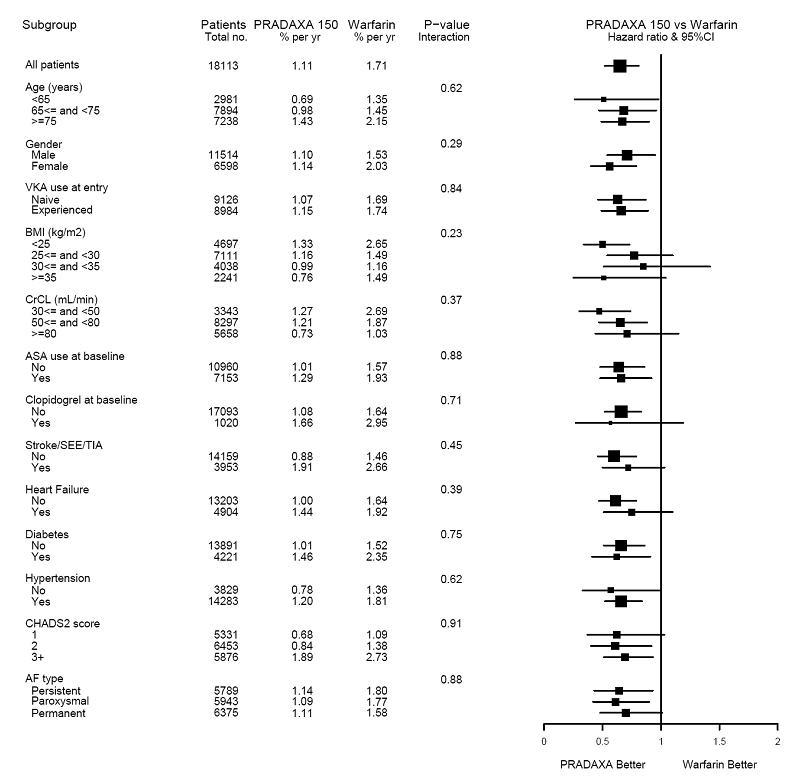
The contributions of the components of the composite endpoint, including stroke by subtype, are shown in Table 5. The treatment effect was primarily a reduction in stroke. PRADAXA 150 mg twice daily significantly reduced both ischemic and hemorrhagic strokes relative to warfarin.
| PRADAXA 150 mg twice daily | Warfarin | Hazard ratio vs. warfarin
(95% CI) |
|
| Patients randomized | 6076 | 6022 | |
| Stroke | 122 | 186 | 0.64 (0.51, 0.81) |
| Ischemic stroke | 103 | 134 | 0.75 (0.58, 0.97) |
| Hemorrhagic stroke | 12 | 45 | 0.26 (0.14, 0.49) |
| Systemic embolism | 13 | 21 | 0.61 (0.30, 1.21) |
The efficacy of PRADAXA 150 mg twice daily was generally consistent across major subgroups (see Figure 3).
Figure 3 Stroke and Systemic Embolism Hazard Ratios by Baseline Characteristics

Centers were ranked post hoc by the percentage of time that warfarin-treated patients were in therapeutic range (INR 2 to 3). Findings for stroke/systemic embolism, all-cause mortality, and major bleeds are shown for centers above and below the median level of INR control in Table 6. The benefits of PRADAXA 150 mg relative to warfarin were most apparent in patients enrolled at centers with INR control below the median.
| Centers with INR control below the median of 67% | Centers with INR control above the median of 67% |
|
| Stroke/systemic embolism | 0.57 (0.42, 0.76) | 0.76 (0.55, 1.05) |
| All-cause mortality | 0.78 (0.66, 0.93) | 1.01 (0.84, 1.23) |
| Major bleed | 0.82 (0.68, 0.99) | 1.08 (0.89, 1.31) |
The risk of myocardial infarction was numerically greater in patients who received PRADAXA (1.5% for 150 mg dose) than in those who received warfarin (1.1%).
16 HOW SUPPLIED/STORAGE AND HANDLING
PRADAXA 75 mg capsules have a cream-colored opaque cap imprinted with the Boehringer Ingelheim company symbol and a cream-colored opaque body imprinted with "R75". The color of the imprinting is black. The capsules are supplied in the packages listed:
- NDC 0597-0149-54 Unit of use bottle of 60 capsules
- NDC 0597-0149-60 Blister package containing 60 capsules (10 x 6 capsule blister cards)
PRADAXA 150 mg capsules have a light blue opaque cap imprinted with the Boehringer Ingelheim company symbol and a cream-colored opaque body imprinted with "R150". The color of the imprinting is black. The capsules are supplied in the packages listed:
- NDC 0597-0135-54 Unit of use bottle of 60 capsules
- NDC 0597-0135-60 Blister package containing 60 capsules (10 x 6 capsule blister cards)
Bottles
Store at 25°C (77°F); excursions permitted to 15°-30°C (59°-86°F). Once opened, the product must be used within 4 months. Keep the bottle tightly closed. Store in the original package to protect from moisture.
Blisters
Store at 25°C (77°F); excursions permitted to 15°-30°C (59°-86°F). Store in the original package to protect from moisture.
Keep out of the reach of children.
17 PATIENT COUNSELING INFORMATION
See FDA-approved patient labeling (Medication Guide)
17.1 Instructions for Patients
- Tell patients to take PRADAXA exactly as prescribed.
- Remind patients not to discontinue PRADAXA without talking to the health care provider who prescribed it.
- Keep PRADAXA in the original bottle to protect from moisture. Do not put PRADAXA in pill boxes or pill organizers.
- When more than one bottle is dispensed to the patient, instruct them to open only one bottle at a time.
- Instruct patient to remove only one capsule from the opened bottle at the time of use. The bottle should be immediately and tightly closed.
- Advise patients not to chew or break the capsules before swallowing them and not to open the capsules and take the pellets alone.
17.2 Bleeding
Inform patients that they may bleed more easily, may bleed longer, and should call their health care provider for any signs or symptoms of bleeding.
Instruct patients to seek emergency care right away if they have any of the following, which may be a sign or symptom of serious bleeding:
- Unusual bruising (bruises that appear without known cause or that get bigger)
- Pink or brown urine
- Red or black, tarry stools
- Coughing up blood
- Vomiting blood, or vomit that looks like coffee grounds
Instruct patients to call their health care provider or to get prompt medical attention if they experience any signs or symptoms of bleeding:
- Pain, swelling or discomfort in a joint
- Headaches, dizziness, or weakness
- Reoccurring nose bleeds
- Unusual bleeding from gums
- Bleeding from a cut that takes a long time to stop
- Menstrual bleeding or vaginal bleeding that is heavier than normal
17.3 Gastrointestinal Adverse Reactions
Instruct patients to call their health care provider if they experience any signs or symptoms of dyspepsia or gastritis:
- Dyspepsia (upset stomach), burning, or nausea
- Abdominal pain or discomfort
- Epigastric discomfort, GERD (gastric indigestion)
17.4 Invasive or Surgical Procedures
Instruct patients to inform their health care provider that they are taking PRADAXA before any invasive procedure (including dental procedures) is scheduled.
17.5 Concomitant Medications
Ask patients to list all prescription medications, over-the-counter medications, or dietary supplements they are taking or plan to take so their health care provider knows about other treatments that may affect bleeding risk (e.g., aspirin or NSAIDs) or dabigatran exposure (e.g., dronedarone or systemic ketoconazole).
MEDICATION GUIDE
PRADAXA (pra dax´ a)
(dabigatran etexilate mesylate)
capsules
Read this Medication Guide before you start taking PRADAXA and each time you get a refill. There may be new information. This Medication Guide does not take the place of talking with your doctor about your medical condition or your treatment.
What is the most important information I should know about PRADAXA?
- PRADAXA can cause bleeding which can be serious, and sometimes lead to death. This is because PRADAXA is a blood thinner medicine that lowers the chance of blood clots forming in your body.
-
You may have a higher risk of bleeding if you take PRADAXA and:
- are over 75 years old
- have kidney problems
- have stomach or intestine bleeding that is recent or keeps coming back, or you have a stomach ulcer
- take other medicines that increase your risk of bleeding, including:
- aspirin or aspirin containing products
- long-term (chronic) use of non-steroidal anti-inflammatory drugs (NSAIDs)
- warfarin sodium (Coumadin®, Jantoven®)
- a medicine that contains heparin
- clopidogrel (Plavix®)
- prasugrel (Effient®)
- have certain kidney problems and also take the medicines dronedarone (Multaq®) or ketoconazole tablets (Nizoral®).
Tell your doctor if you take any of these medicines. Ask your doctor or pharmacist if you are not sure if your medicine is one listed above.
- PRADAXA can increase your risk of bleeding because it lessens the ability of your blood to clot. While you take PRADAXA:
- you may bruise more easily
- it may take longer for any bleeding to stop
Call your doctor or get medical help right away if you have any of these signs or symptoms of bleeding:- unexpected bleeding or bleeding that lasts a long time, such as:
- unusual bleeding from the gums
- nose bleeds that happen often
- menstrual bleeding or vaginal bleeding that is heavier than normal
- bleeding that is severe or you cannot control
- pink or brown urine
- red or black stools (looks like tar)
- bruises that happen without a known cause or get larger
- cough up blood or blood clots
- vomit blood or your vomit looks like "coffee grounds"
- unexpected pain, swelling, or joint pain
- headaches, feeling dizzy or weak
Take PRADAXA exactly as prescribed. Do not stop taking PRADAXA without first talking to the doctor who prescribes it for you. Stopping PRADAXA may increase your risk of a stroke.
PRADAXA may need to be stopped, if possible, for one or more days before any surgery, or medical or dental procedure. If you need to stop taking PRADAXA for any reason, talk to the doctor who prescribed PRADAXA for you to find out when you should stop taking it. Your doctor will tell you when to start taking PRADAXA again after your surgery or procedure.
See "What are the possible side effects of PRADAXA?" for more information about side effects.
What is PRADAXA?
PRADAXA is a prescription medicine used to reduce the risk of stroke and blood clots in people who have a medical condition called atrial fibrillation. With atrial fibrillation, part of the heart does not beat the way it should. This can lead to blood clots forming and increase your risk of a stroke. PRADAXA is a blood thinner medicine that lowers the chance of blood clots forming in your body.
It is not known if PRADAXA is safe and works in children.
Who should not take PRADAXA?
Do not take PRADAXA if you:
- currently have certain types of abnormal bleeding. Talk to your doctor, before taking PRADAXA if you currently have unusual bleeding.
- have had a serious allergic reaction to PRADAXA. Ask your doctor if you are not sure.
What should I tell my doctor before taking PRADAXA?
Before you take PRADAXA, tell your doctor if you:
- have kidney problems
- have ever had bleeding problems
- have ever had stomach ulcers
- have any other medical condition
- are pregnant or plan to become pregnant. It is not known if PRADAXA will harm your unborn baby.
- are breastfeeding or plan to breastfeed. It is not known if PRADAXA passes into your breast milk.
Tell all of your doctors and dentists that you are taking PRADAXA. They should talk to the doctor who prescribed PRADAXA for you, before you have any surgery, or medical or dental procedure.
Tell your doctor about all the medicines you take, including prescription and non-prescription medicines, vitamins, and herbal supplements. Some of your other medicines may affect the way PRADAXA works. Certain medicines may increase your risk of bleeding. See "What is the most important information I should know about PRADAXA?"
Especially tell your doctor if you take:- rifampin (Rifater, Rifamate, Rimactane, Rifadin)
Know the medicines you take. Keep a list of them and show it to your doctor and pharmacist when you get a new medicine.
How should I take PRADAXA?
- Take PRADAXA exactly as prescribed by your doctor.
- Do not take PRADAXA more often than your doctor tells you to.
- You can take PRADAXA with or without food.
- PRADAXA comes in a bottle or in a blister package.
- Only open 1 bottle of PRADAXA at a time. Finish your opened bottle of PRADAXA before opening a new bottle.
- After opening a bottle of PRADAXA, use within 4 months. See "How should I store PRADAXA?"
- When it is time for you to take a dose of PRADAXA, only remove your prescribed dose of PRADAXA from your open bottle or blister package.
- Tightly close your bottle of PRADAXA right away after you take your dose.
- Swallow PRADAXA capsules whole. Do not break, chew, or empty the pellets from the capsule.
- If you miss a dose of PRADAXA, take it as soon as you remember. If your next dose is less than 6 hours away, skip the missed dose. Do not take two doses of PRADAXA at the same time.
- Your doctor will decide how long you should take PRADAXA. Do not stop taking PRADAXA without first talking with your doctor. Stopping PRADAXA may increase your risk of stroke.
- Do not run out of PRADAXA. Refill your prescription before you run out. If you plan to have surgery, or a medical or a dental procedure, tell your doctor and dentist that you are taking PRADAXA. You may have to stop taking PRADAXA for a short time. See "What is the most important information I should know about PRADAXA?"
- If you take too much PRADAXA, go to the nearest hospital emergency room or call your doctor.
- Call your healthcare provider right away if you fall or injure yourself, especially if you hit your head. Your healthcare provider may need to check you.
What are the possible side effects of PRADAXA?
PRADAXA can cause serious side effects.
- See "What is the most important information I should know about PRADAXA?"
- Allergic Reactions. In some people, PRADAXA can cause symptoms of an allergic reaction, including hives, rash, and itching. Tell your doctor or get medical help right away if you get any of the following symptoms of a serious allergic reaction with PRADAXA:
- chest pain or chest tightness
- swelling of your face or tongue
- trouble breathing or wheezing
- feeling dizzy or faint
Common side effects of PRADAXA include:
- indigestion, upset stomach, or burning
- stomach pain
Tell your doctor if you have any side effect that bothers you or that does not go away.
These are not all of the possible side effects of PRADAXA. For more information, ask your doctor or pharmacist.
Call your doctor for medical advice about side effects. You may report side effects to FDA at 1-800-FDA-1088.
How should I store PRADAXA?
- Store PRADAXA at room temperature between 59°F to 86°F (15°C to 30°C). After opening the bottle, use PRADAXA within 4 months. Safely throw away any unused PRADAXA after 4 months.
- Keep PRADAXA in the original bottle or blister package to keep it dry (protect the capsules from moisture). Do not put PRADAXA in pill boxes or pill organizers.
- Tightly close your bottle of PRADAXA right away after you take your dose.
Keep PRADAXA and all medicines out of the reach of children.
General information about PRADAXA
Medicines are sometimes prescribed for purposes other than those listed in a Medication Guide. Do not use PRADAXA for a condition for which it was not prescribed. Do not give your PRADAXA to other people, even if they have the same symptoms. It may harm them.
This Medication Guide summarizes the most important information about PRADAXA. If you would like more information, talk with your doctor. You can ask your pharmacist or doctor for information about PRADAXA that is written for health professionals.
For more information, go to www.PRADAXA.com or call 1-800-542-6257 or (TTY) 1-800-459-9906.
What are the ingredients in PRADAXA?
Active ingredient: dabigatran etexilate mesylate
Inactive ingredients: acacia, dimethicone, hypromellose, hydroxypropyl cellulose, talc, and tartaric acid. The capsule shell is composed of carrageenan, FD&C Blue No. 2 (150 mg strength only), FD&C Yellow No. 6, hypromellose, potassium chloride, titanium dioxide, and black edible ink.
This Medication Guide has been approved by the U.S. Food and Drug Administration.
Distributed by:
Boehringer Ingelheim Pharmaceuticals, Inc.
Ridgefield, CT 06877 USA
Revised: January 2012
The brands listed above are trademarks of their respective owners and are not trademarks of Boehringer Ingelheim Pharmaceuticals, Inc. The owners of these brands are not affiliated with and do not endorse Boehringer Ingelheim Pharmaceuticals, Inc., or its products.
Copyright 2012 Boehringer Ingelheim Pharmaceuticals, Inc.
ALL RIGHTS RESERVED
75461-05
IT5060MA042012
75457-05
IT5400K
| PRADAXA
dabigatran etexilate mesylate capsule |
|||||||||||||||||||||||||
|
|||||||||||||||||||||||||
|
|||||||||||||||||||||||||
|
|||||||||||||||||||||||||
|
|||||||||||||||||||||||||
| Marketing Information | |||
| Marketing Category | Application Number or Monograph Citation | Marketing Start Date | Marketing End Date |
| NDA | NDA022512 | 11/08/2010 | |
| PRADAXA
dabigatran etexilate mesylate capsule |
|||||||||||||||||||||||||
|
|||||||||||||||||||||||||
|
|||||||||||||||||||||||||
|
|||||||||||||||||||||||||
|
|||||||||||||||||||||||||
| Marketing Information | |||
| Marketing Category | Application Number or Monograph Citation | Marketing Start Date | Marketing End Date |
| NDA | NDA022512 | 08/08/2011 | |
| PRADAXA
dabigatran etexilate mesylate capsule |
|||||||||||||||||||||||||||||||||
|
|||||||||||||||||||||||||||||||||
|
|||||||||||||||||||||||||||||||||
|
|||||||||||||||||||||||||||||||||
|
|||||||||||||||||||||||||||||||||
| Marketing Information | |||
| Marketing Category | Application Number or Monograph Citation | Marketing Start Date | Marketing End Date |
| NDA | NDA022512 | 10/26/2010 | |
| Labeler - Boehringer Ingelheim Pharmaceuticals Inc. (603175944) |
| Establishment | |||
| Name | Address | ID/FEI | Operations |
| Boehringer Ingelheim Pharma GmbH and Co. KG | 551147440 | MANUFACTURE, ANALYSIS, API MANUFACTURE, LABEL, PACK | |
| Establishment | |||
| Name | Address | ID/FEI | Operations |
| Bidachem S.p.A. | 429232812 | API MANUFACTURE, ANALYSIS | |
| Establishment | |||
| Name | Address | ID/FEI | Operations |
| Boehringer Ingelheim Roxane Inc | 058839929 | LABEL, PACK | |
| Establishment | |||
| Name | Address | ID/FEI | Operations |
| Micro Macinazione Sa | 485550516 | API MANUFACTURE | |
Revised: 01/2012 Boehringer Ingelheim Pharmaceuticals Inc.
